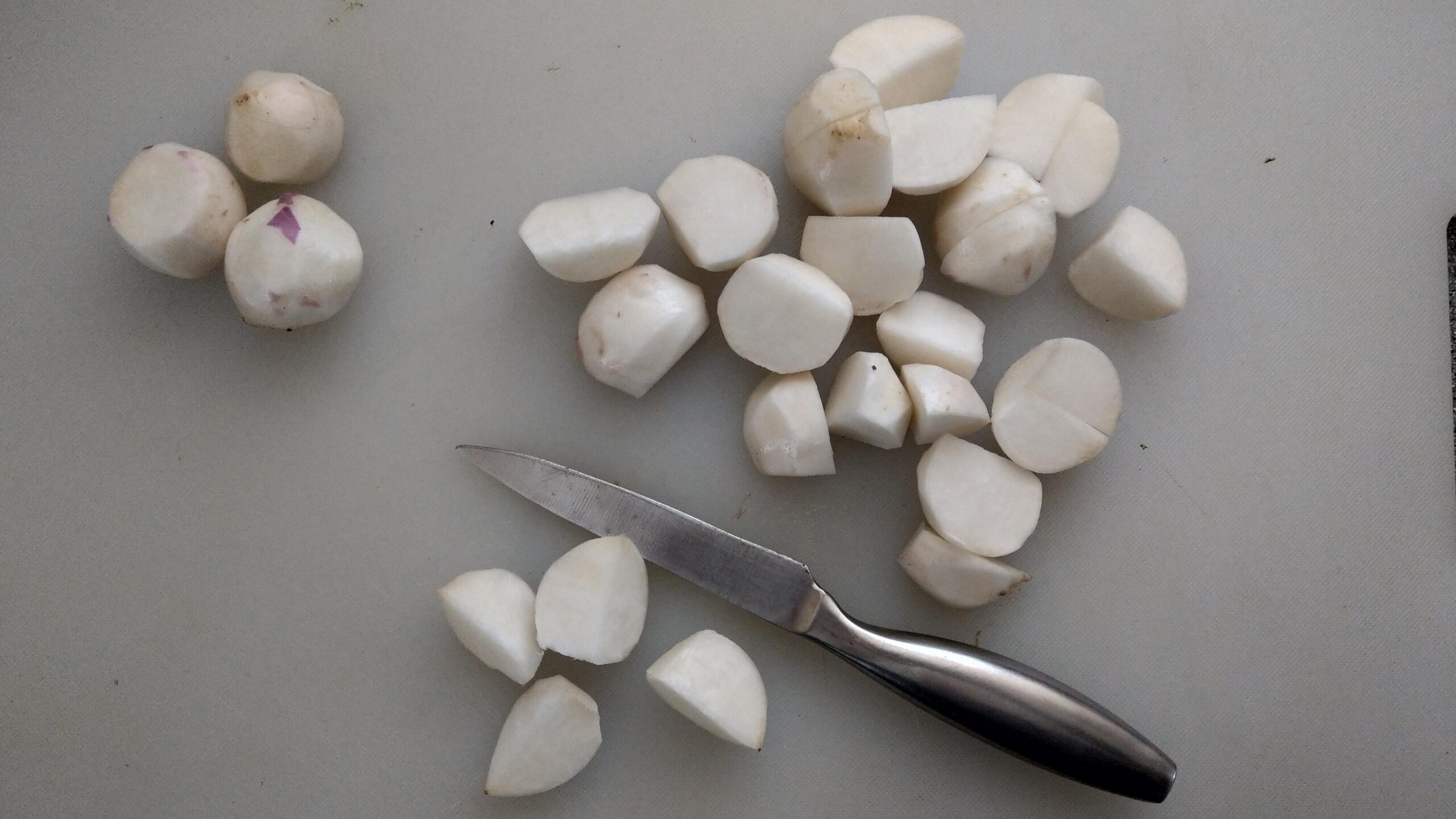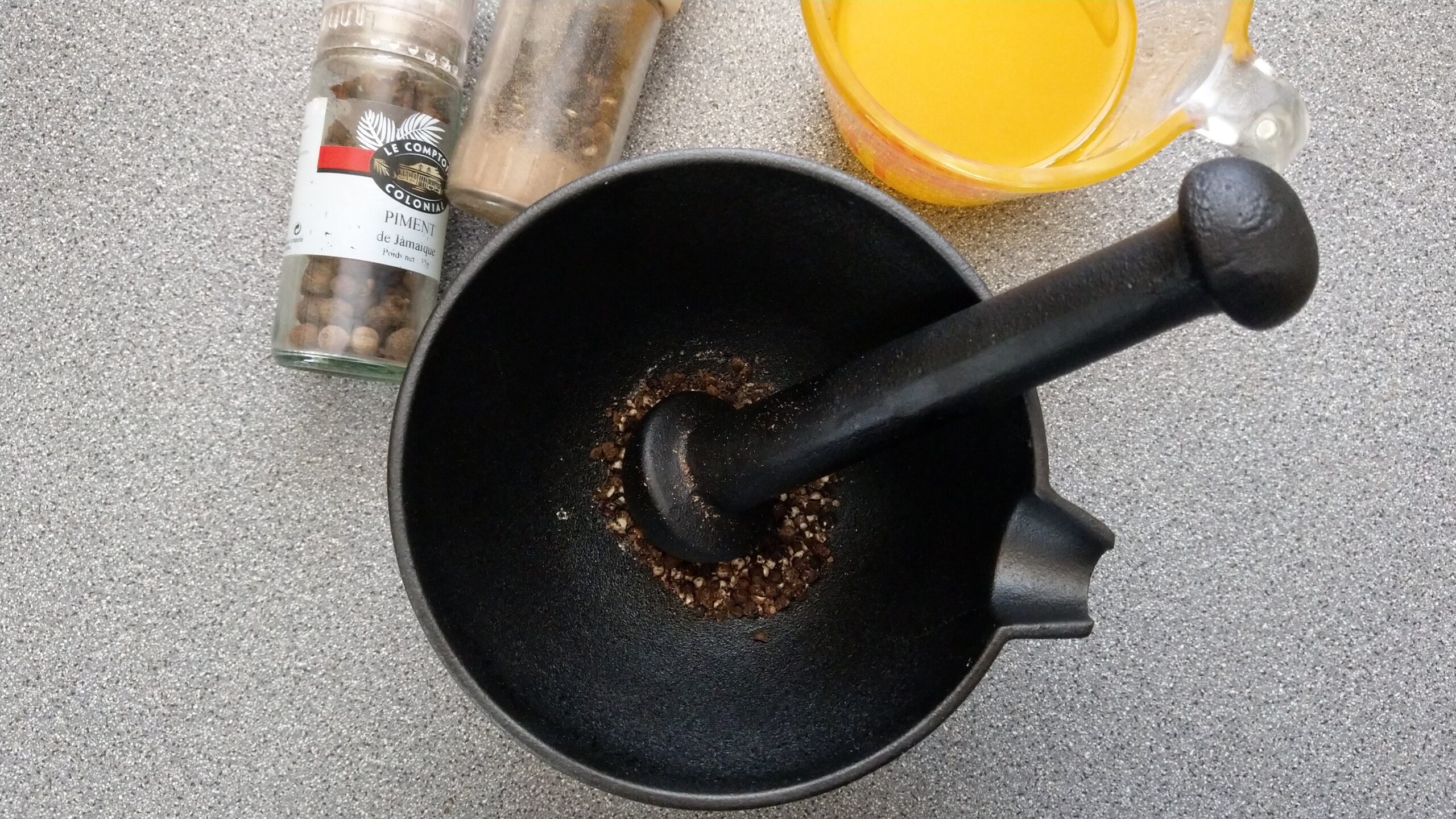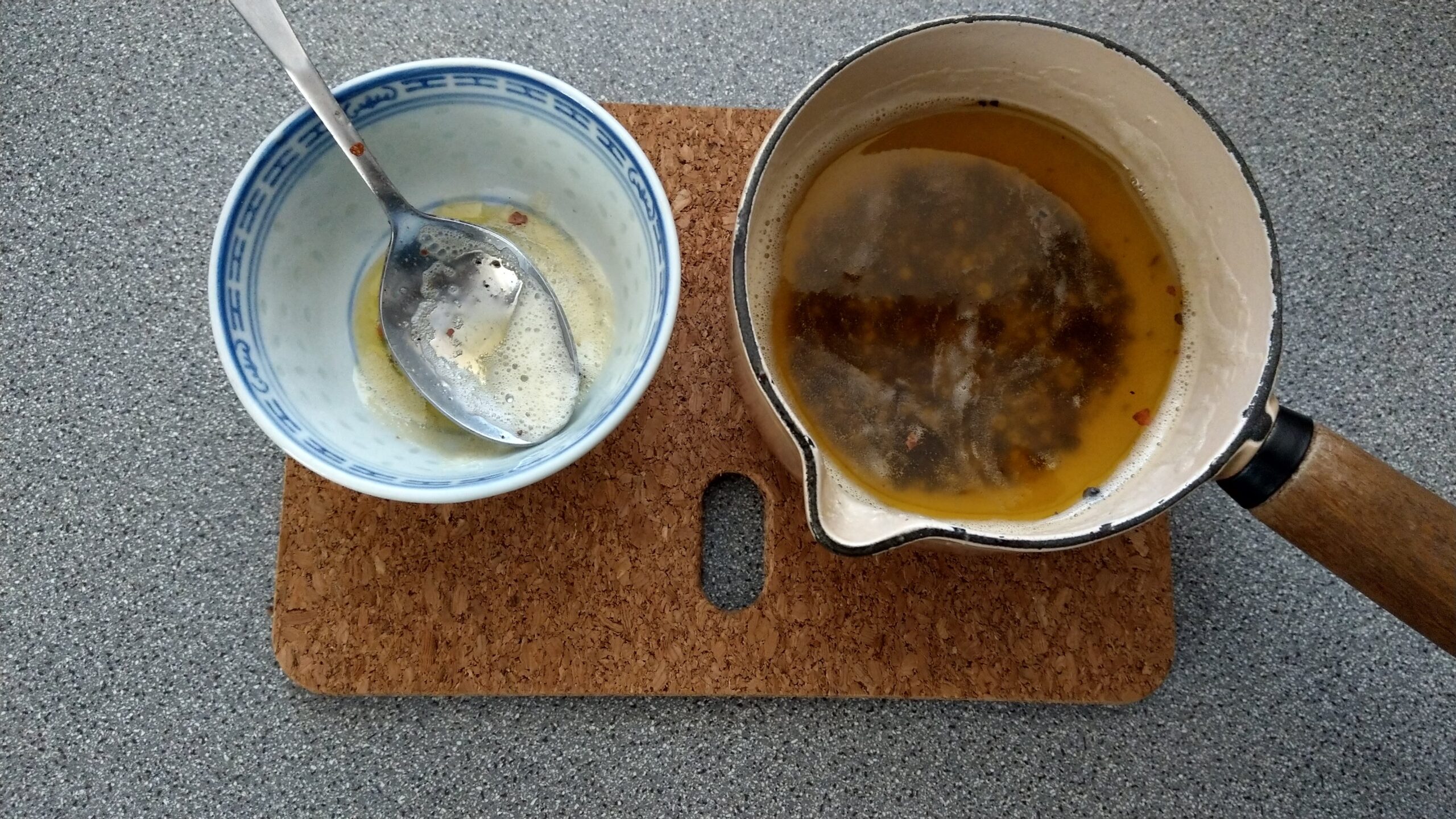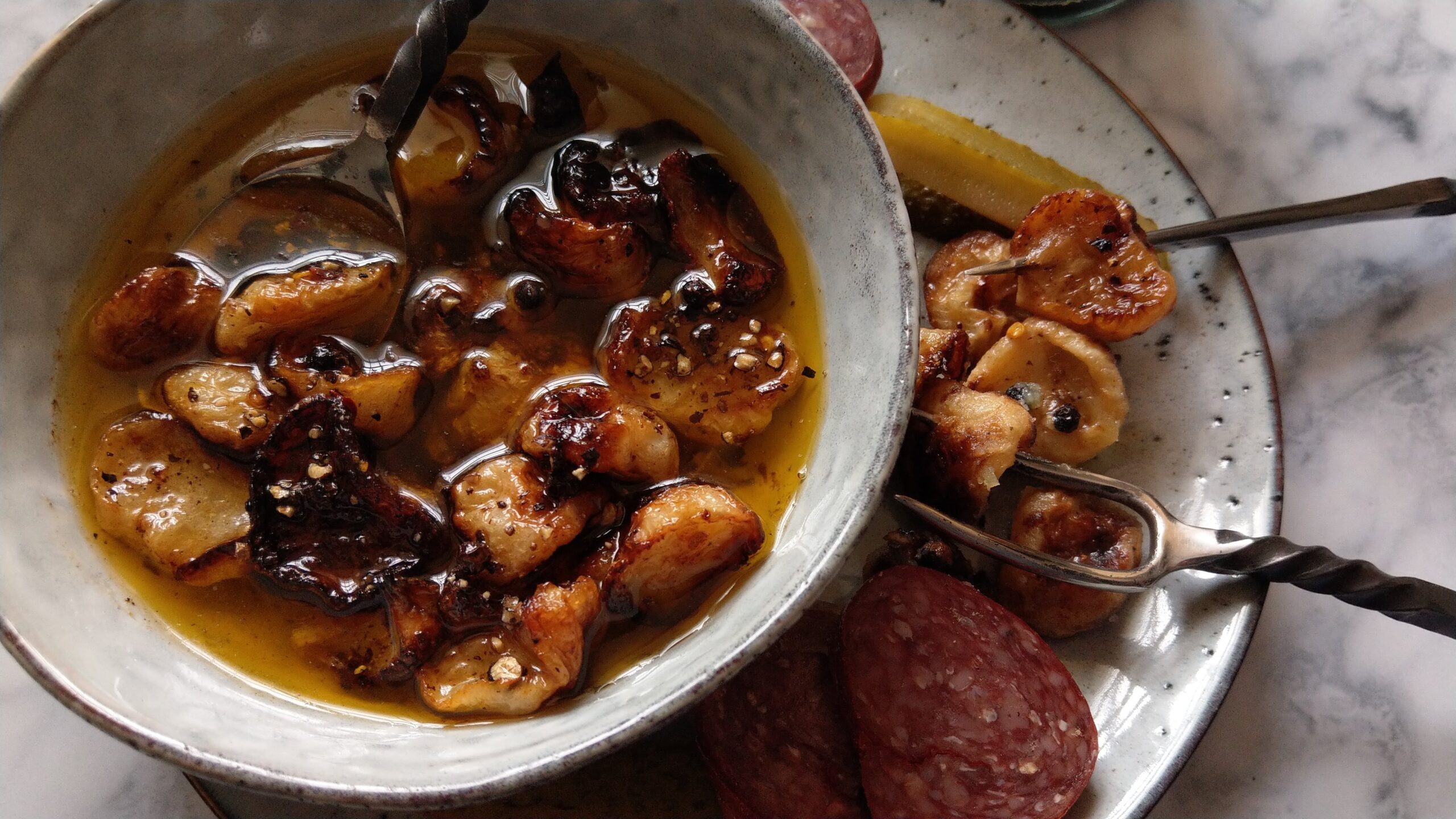Baby Turnips in Berry-Pepper Butter
A much-loved late spring and early summer side dish
- Background
- Recipe
In the latter part of The Door Into Sunset, the outlawed Prince Freelorn—traveling disguised as a tinker through the Arlene midlands—passes through a small town called Elefrua, near the farm where (as royalty usually are) he was “fostered out” as a child. There, after selling off some of his stock of pots and pans in the daily market, he stops in a tavern for a meal that will unexpectedly prove vitally important to him personally, and to the nature of the wider conflict to come. But for that moment, the food’s of far more import.
…Lorn reached for the first of the pig trotters. They had been boiled with sage and bay, then soused in cider, from the divine smell of them, and afterwards burnt brown under a hot iron until the skin had gone crisp. The roast turnips in their bowl were swimming and simmering in a lake of butter and ground berry-pepper…
The method by which the trotters are made has been described elsewhere. But the baby turnips are entitled to some attention, not least because of their spicing. In our world, such lavish use of pepper in a European-flavored medieval setting would cause understandable questions about expense and availability—but not in the Middle Kingdoms.
Some clarification of terms is necessary here. “Berry-pepper” (Arl. and N.Arl. enédhwe, Dar. edwesh, Stel. uékwet), is a common class-term in the Four Realms for a range of small spiceries that, though they may come from very different kinds of plants, wind up looking (at the users’ end) much the same. The Middle Kingdoms variants of our Earth’s cubeb pepper (Piper cubeba medioregnis) and Sichuan pepper (Xenozanthoxylum microdraconis), for example, would be considered berry-peppers. But when most people in the Realms say “berry-pepper”, the one they usually mean is the commonest and most accessible of the class—the local version of our Piper nigrum or black pepper.
Due to the relatively limited cultivation area of P. nigrum on our Earth during the western medieval period, and the great distances it had to be brought from the countries where it was grown, black peppercorns became a commodity of great enough price to occasionally be used as money. But no such conditions have ever obtained in the Four Realms. After the destruction of the Dark, the original migrants into what would become the Middle Kingdoms found P. nigrum medioregnis growing there wild when they arrived. The generally subtropical climate of the northern regions of the Four Realms has meant that, at one time or another, black pepper has been grown in small amounts and with varying levels of success almost everywhere along the northern coasts of Darthen and Arlen with the Sea. But the best conditions for growing it by far are to be found in the rain-forested hill country on either coast of the North Arlene peninsula.
In particular, the near-tropical climate prevailing in the far north of the peninsula—from the Eorlhowe at its tip to some fifty leagues south—makes for some of the most perfect territory possible for pepper cultivation. The relatively heavy rainfall and high temperatures experienced there year round, almost always moderated by the prevailing southeasterlies of the latitude (between 20º and 30º south of that Earth’s equator), encouraged the North Arlene crown of centuries past to begin subsidized cultivation of the spice in the 1500s, under the supervision of the so-called Spice Clans who flourished during the 1500s-1900s p.a.d.
Those families (and the internecine feuds associated with them, immemorialized in the famed Enedhwáilion cycle of North Arlene epic poems) are of course now gone, and the protection and governance of the Pepper Lands long since seconded to the Arlene Throne. But the wideflung trade that the Spice Clans began continues, and “the Queen of Spices” is shipped in significant tonnages throughout the breadth and length of the Four Realms as part of the routine coastal and river trade.
Black pepper’s cheapness and ready availability makes it a favorite seasoning for all kinds of dishes, both sweet and savory, on tables both urban and rural. In farm country it frequently turns up in considerable amounts in seasonal meat, fish and vegetable dishes that are meant to stand on their basic flavor and freshness, and are judged to work better with simple treatments than with more complicated spicery or assortments of ingredients.
The simple but scrumptious turnip recipe that Lorn is so glad to eat again at Marbhan’s cookshop-cum-tavern in Elefrua is dependent not just on profligate use of black pepper, but also on local market gardeners producing a relatively constant supply of young vegetables (and sometimes getting around seasonal limitations with the aid of local magic-workers). After that, all the local tavernkeeper needs to produce the dish at short order is a bake-oven already running at afternoon heat for the benefit of locals who want to bring in their home cooking to roast or bake in the residual heat. Or (at our end of time and multidimensional space) a quick parboil followed by half an hour on a baking sheet will do the trick… and then a deep dive into a bowlful of melted or clarified butter.
As regards the turnips: in any region or market where they aren’t being raised hydroponically, baby ones tend to be extremely seasonal. Interested parties will probably have to make do with more adult turnips most of the time. The main snare lying in the cook’s path in either case is to make sure that they’ve purchased true turnips (Brassica rapa) and not rutabagas or swedes (Brassica napus), which are sometimes accidentally (or on purpose…) passed off or mislabeled as turnips. Their flavor and texture are far inferior to the simultaneously delicate and earthy flavor of the turnip—especially the baby ones—and in Arlen are seen as fit only to feed livestock who’re being overwintered in the sheds. So let the buyer beware…
The ingredients (per hungry King-to-be or other enthusiastic diner):
- 8-12 baby turnips
- 100g butter, melted and clarified
- 10-15 black peppercorns, cracked/crushed
- Coarse salt to taste
The method:
Wash your baby turnips and chop off the green tops and the root ends.

If desired, scrape or peel the turnips. (Note that if yours are young enough, you don’t really need to do this: the peels will become as tender as the turnips inside during their cooking, if not tenderer. …We peeled the ones pictured in this process to see if they tasted any different, or better, than an earlier pass at the recipe that left the peels on. As far as we could tell, peeling or not-peeling made no difference whatsoever.)
Chop the peeled (or not-peeled) turnips into bite-sized pieces. (Mostly, if your turnips are small enough, this simply means halving them. If they’re much bigger than golf balls, quarter them.)

Bring a pot of water to a boil and parboil the turnips for 5-7 minutes.
While this is going on, crush or crack your peppercorns. (Pre-cracked peppercorns will always have lost some of their [aromatic] virtue by the time you make this dish, so it’s best to do the cracking just before cooking time.)

When you’ve cracked the peppercorns, get your butter ready to go. If you’re using fresh butter, melt it, remove it from heat and allow the milk solids to settle, then pour off the clear butterfat from on top. If you’re using butter that’s already clarified, you needn’t bother with this step.
Put the butter into a little pan and add the cracked pepper to it. Heat it gently and let the pepper steep in it.

A note about this, if you’ve just clarified this butter by the melt-and-pour process: The butter may froth a little as it starts to heat up. You need to skim this froth off as it forms, or it will scorch.
Whether you’ve needed to skim the butter or not, watch its heat carefully in the early part of this process. You will want this butter to brown somewhat, eventually… but if this happens too soon you might burn it. For this part of the cooking process, low heat is best. …Stir the mixture occasionally to make sure that the flavor of the peppercorns has a chance to mingle itself well with the melted butter.
Now preheat your oven to 180ºC/375ºF.
When the turnips have finished parboiling, drain them well. When they’re drained dry, put them in a bowl and toss them lightly with the vegetable oil of your choice. (In the Kingdoms, favored oils for this are olive oil, pumpkin oil or sunflower oil, depending on regional preference.) Once the turnips are coated with the oil, scatter them over a nonstick baking sheet and sprinkle them with the coarse salt.

Put the turnips into the preheated oven and let them roast for about 30 minutes. At the 15-minute point or thereabouts, pull the baking sheet out and toss the turnips with a spatula to expose parts that haven’t started to color yet: then put them back in to finish their roasting time.
About five minutes before the turnips are ready, increase the heat under the butter so that it starts to brown. Keep your eye on it and remove it from heat as soon as it starts to significantly color, as the pot will hold some heat and keep cooking the contents even after you’ve moved it off the heat.
As soon as the turnips are done, get them out of the oven and remove them to the (heatproof!) bowl from which you’re going to serve them. Then dump the pepper butter over them and toss them in it well. Grind a little more pepper over them if you like, and serve them as hot as possible.
Enjoy!

Vegetables, side dish
SuperValu



